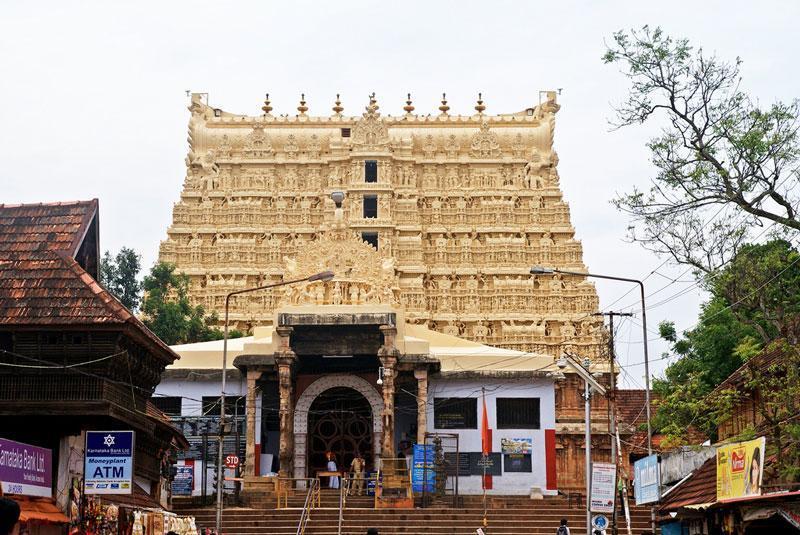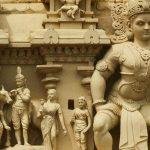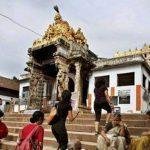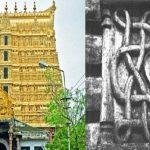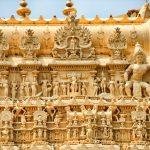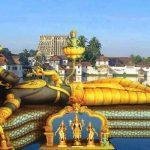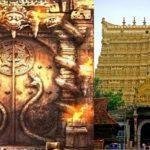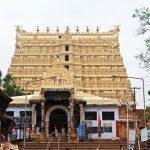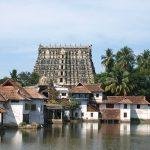Contents
Padmanabhaswamy Temple, Thiruvananthapuram, Kerala
| Date built: | – |
|---|---|
| – | |
| Architectural style: | Dravidian architecture, Architecture of Kerala |
| Major festivals | – |
| Locale: | Thiruvananthapuram |
| District:: | Thiruvananthapuram |
| Address: | West Nada, Fort, East Fort, Pazhavangadi, Thiruvananthapuram, Kerala 695023 |
| Phone | 04712464606 |
Padmanabhaswamy Temple is located in Thiruvananthapuram, Kerala, India. The temple is built in an intricate fusion of the indigenous Kerala style and the Tamil style (kovil) of architecture associated with the temples located in the neighbouring state of Tamil Nadu, featuring high walls, and a 16th-century Gopuram.While the Moolasthanam of the temple is the Ananthapuram Temple in Kumbala in Kasargod District, architecturally to some extent, the temple is a replica of the Adikesava Perumal templelocated in Thiruvattar, Kanyakumari District.
The principal deity Vishnu is enshrined in the “Anantha Shayanam” posture, the eternal yogic sleep on the serpent Adisheshan.Sree Padmanabhaswamy is the tutelary deity of the royal family of Travancore. The titular Maharaja of Travancore Moolam Thirunal Rama Varma is the trustee of the temple. In line with the Temple Entry Proclamation, only those who profess the Hindu faith are permitted entry to the temple and devotees have to strictly follow the dress code.The name of the city of Thiruvananthapuram in Malayalam translates to “The City of Lord Ananta”, referring to the deity of Padmanabhaswamy Temple.
Architecture
In the sanctum sanctorum, Padmanabha reclines on the serpent Anantha or Adi Sesha.[19] The serpent has five hoods facing inwards, signifying contemplation. The Lord’s right hand is placed over a Shiva lingam. Sridevi-Lakshmi, the Goddess of Prosperity and Bhudevi the Goddess of Earth, two consorts of Vishnu are by his side. Brahma emerges on a lotus, which emanates from the navel of the Lord. The deity is made from 12,008 saligramams.[20] These saligrams are from the banks of the Gandaki River in Nepal, and to commemorate this certain rituals used to be performed at the Pashupatinath Temple.The deity of Padmanabha is covered with, “Katusarkara yogam”, a special ayurvedic mix, which forms a plaster that keeps the deity clean. The daily worship is with flowers and for the abhishekam, special deities are used.The platforms in front of the vimanam and where the deity rests are both carved out of a single massive stone and hence called “Ottakkal-mandapam”. On the orders of Marthanda Varma (1706–58), the Ottakkal-mandapam was cut out of a rock at Thirumala, about 4 miles (6.4 km) north of the temple. It measured 20 square feet (1.9 m2; 190 dm2; 19,000 cm2) in area by 2.5 feet (30 in; 7.6 dm; 76 cm) thick and was placed in front of the deity in the month of Edavom 906 M.E. (1731 CE). At the same time, Marthanda Varma also brought 12,000 shaligrams, aniconic representations of Vishnu, from the Gandaki River, north of Benares (now known as Varanasi) to the temple. These were used in the reconsecration of the Padmanabha.
n order to perform darshan and puja, one has to ascend to the mandapam. The Deity is visible through three doors – the visage of the reclining Lord and Siva Linga underneath the hand is seen through the first door; Sridevi and Bhrigu Muni in Katusarkara, Brahma seated on a lotus emanating from the Lord’s navel, hence the name, “Padmanabha”, gold abhisheka moorthies of Lord Padmanabha, Sridevi and Bhudevi, and silver utsava moorthi of Padmanabha through the second door; the Lord’s feet, and Bhudevi and Markandeya Muni in Katusarkara through the third door. The idols of two goddesses holding chamaram, Garuda, Narada, Tumburu, the divine forms of the six weapons of Lord Vishnu, Surya, Chandra, Saptarshi(Seven Sages), Madhu, and Kaitabha are also there in the Sanctum. Only the King of Travancore may perform sashtanga namaskaram, or prostrate on the “Ottakkal Mandapam”. It is traditionally held that anybody who prostrates on the mandapam has surrendered all that he possesses to the Deity. Since the ruler has already done that, he is permitted to prostrate on this mandapam.
Legend / Local stories.
Several extant Hindu Texts like the Brahma Purana, Matsya Purana, Varaha Purana, Skanda Purana, Padma Purana, Vayu Purana, Bhagavata Purana and the Mahabharata mention this shrine. The Temple has been referred to in the (only recorded) Sangam Period of literature between 500 B.C and 300 A.D several times.Many conventional historians and scholars are of the opinion that one of the names that the Temple had – “The Golden Temple” – literally was in cognizance of the fact that the Temple was already unimaginably wealthy by that point.Many extant pieces of Sangam Tamil literature and poetry, and even the later works of Ninth Century Tamil poet-saints like Nammalwar, refer to the Temple and even the city as having walls of pure gold. At some places, both the Temple and the entire city are often eulogized even as being made of gold, and the Temple as Heaven.[12][13]
The temple is one of the 108 principal Divya Desams (“Holy Abodes”) in Vaishnavism, and is glorified in the Divya Prabandha.[citation needed] The Divya Prabandha glorifies this shrine as being among the 13 Divya Desam in Malai Nadu (corresponding to present-day Kerala and some adjoining areas).The 8th century Tamil poet Alvar Nammalvar sang the glories of Padmanabha.The Ananthapuram Temple in Kasargod is believed to be the ‘Moolasthanam’ of the Temple.
The sage Vilvamangalathu Swamiyar, who resided near Ananthapuram Temple in Kasargod District, prayed to Lord Vishnu for his darshan or “auspicious sight”. The Lord is believed to have come in the guise of a little boy who was mischievous. The boy defiled the Idol which was kept for Puja. The sage became enraged at this and chased away the boy, who disappeared. After a long search, when he was walking on the banks of Arabian Sea, he heard a pulaya lady threatening her child that she would throw him in Ananthankadu. The moment the Swami heard the word Ananthankadu he was delighted. He proceeded to Ananthankadu based on the directions of the lady of whom he enquired. The Sage reached Ananthankadu searching for the boy. There he saw the boy merging into an Iluppa tree (Indian Butter Tree). The tree fell down and became Anantha Sayana Moorti (Vishnu reclining on the celestial snake Anantha). But the edifice that the Lord assumed was of an extraordinarily large size, with His head at Thiruvallom, navel at Thiruvananthapuram, and lotus-feet at Thrippadapuram (Thrippappur), making him some eight miles in length. The Sage requested the Lord to shrink to a smaller proportion that would be thrice the length of his staff. Immediately the Lord shrank to the form of the Idol that is seen at present in the Temple. But even then many Iluppa trees obstructed a complete vision of the Lord. The Sage saw the Lord in three parts – thirumukham, thiruvudal and thrippadam. Swami prayed to Padmanabha to be forgiven. The Swami offered Rice Kanji and Uppumanga (salted mango pieces) in a coconut shell to the Perumal which he obtained from the pulaya woman. The spot where the Sage had darsan of the Lord belonged to Koopakkara Potti and Karuva Potti. With the assistance of the reigning King and some Brahmin households a Temple was constructed. Koopakkara Potti was made the Tantri of the Temple.The Ananthankadu Nagaraja Temple still exists to the north west of the Padmanabhaswamy Temple. The Samadhi (final resting place) of the Swamiyar exists to the west of the Padmanabha Temple. A Krishna Temple was built over the Samadhi. This Temple, known as Vilvamangalam Sri Krishna Swami Temple, belongs to Thrissur Naduvil Madhom
Photo Gallery
How to Reach:
Contact Details
Official Address

